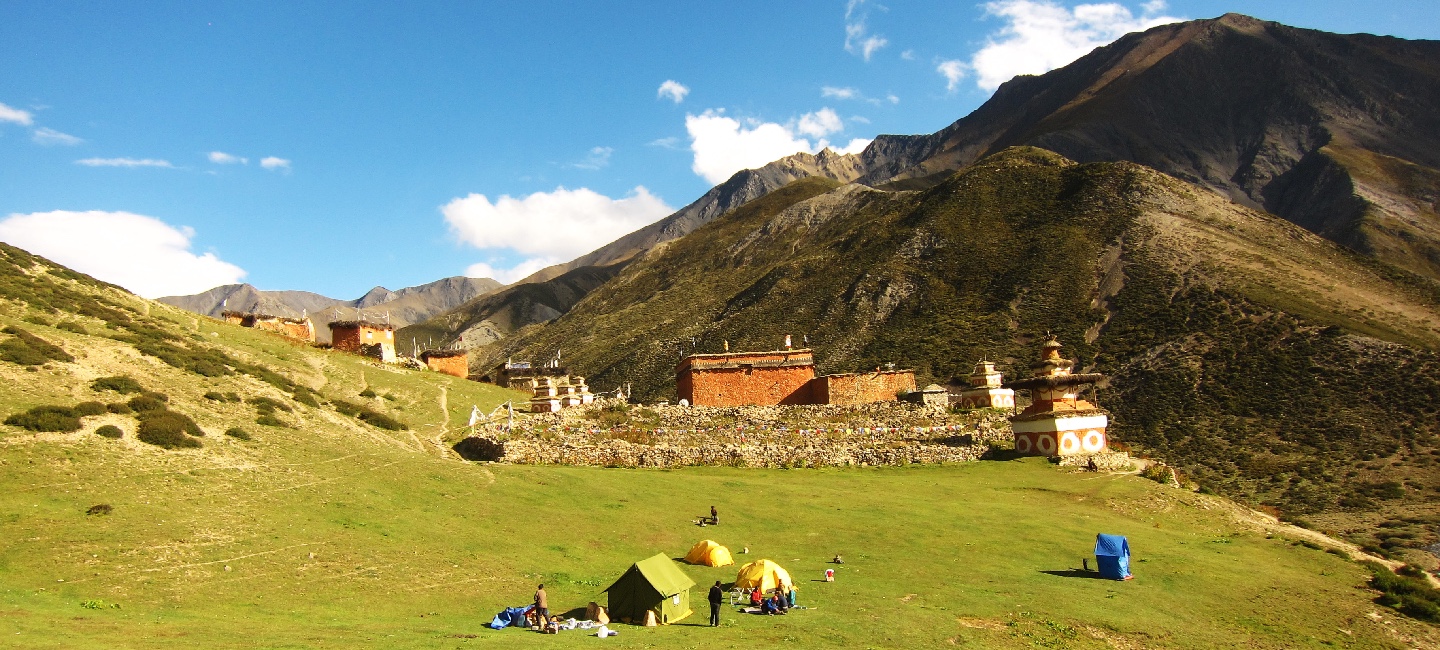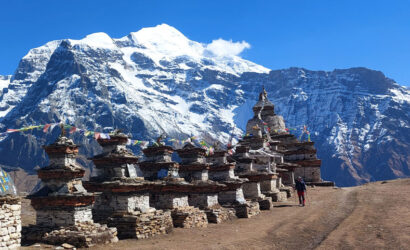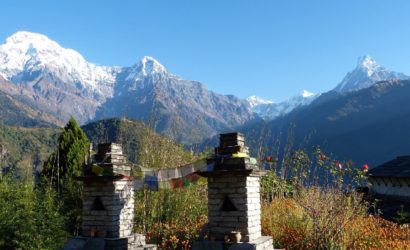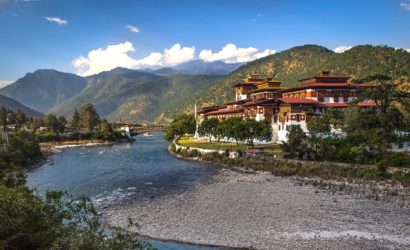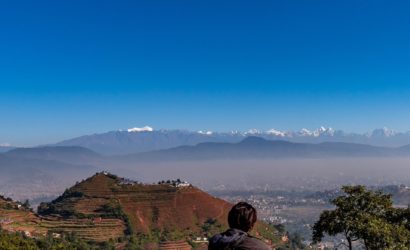Dolpo, a land beyond the Himalaya, conjures up visions of mysterious monasteries, snow leopards and blue sheep, it is situated in the western part of the country, and is one of the most remote regions in Nepal. The Upper Dolpo Trek discovers the very isolated area in Dolpo which has been strictly off-limits until only recently, so the traditions and way of life have remained intact. In the autumn of 1990 the first British tour operator organized a trek from east to west, from Pokhara to Jumla through Lower Dolpo.
The Upper Dolpo Trek trail passes many gigantic mountain ranges – Annapurna , Dhaulagiri and Kanjiroba, to name but a few – and passed through Lower Dolpo, at one time a small kingdom in its own right. More recently we have repeated the route, with variations and our groups see very few other Europeans so they are enthused greatly about the wild remoteness, the stunning mountain scenery and the fact that the local people had that innocent friendliness peculiar to people who live in excessively remote mountainous regions.
The people who live here are just a few hundred and are among the highest inhabitants of the world. Upper Dolpo villages are 4,300 meters above sea level. In particular, here people are still practicing the pre-Buddhist Bon Po religion. After Buddhist doctrine began to spread throughout Tibet in the 9th century, this early sect was almost completely replaced.
The snow leopard of Peter Matthiessen and the Himalayan Pilgrimage of David Snellgrove contributed to Dolpo’s mysticism and attraction. Both writers visited the Shey Gompa in the inner Dolpo, north of Phoksundo Lake. This is most trekkers ‘ goal, but this Upper Dolpo trek will take you into this mysterious land even further.
Upper Dolpo Trek Difficulty
It is considered challenging to trek in Upper Dolpo. There are steep climbs, three passes above 5000 meters, several nights over 3500 meters. And some long, six-hours or more trekking days. The fact that this is a camping trek adds to the physical challenge and discomfort of hiking in Upper Dolpo, and it is recommended to have rest days.
This isn’t a trek for a beginner or to try if it’s your first time in Nepal. But for experienced trekkers and repeat visitors to Nepal, it’s going to be a worthwhile challenge!
Getting to Upper Dolpo Trek
Western Nepal is more remote than other parts of Nepal, making access more difficult. You have to get to Nepalgunj first, on the plains, and then to Juphal in the district of Dolpo
Most people fly either from Kathmandu or from Pokhara to Nepalgunj. You then fly to Juphal from Nepalgunj. (Flying directly from Kathmandu to Juphal is not possible, although expensive charter flights can be arranged from Pokhara.) Most of the organized trips will fly from Kathmandu. Keep in mind that Juphal airport is just a small mountain airstrip, where bad weather can often delay flights.
Nepalgunj is also accessible by road, but from Kathmandu or Pokhara it is a long journey. Roads are improving across Western Nepal, but Juphal is now walking from the nearest road-head for several days.
Upon your arrival in the Kathmandu airport after completing your custom formalities Visa, etc. pick up your luggage and look for our airport representative from Himalaya Discovery Adventures, who will display your name on the board at the arrival gate. You will be greeted by our representative and transferred to the hotel by private tourist vehicle. Overnight at hotel in Kathmandu.
Today is free for sightseeing in Kathmandu. You may wish to visit Durbar Square in the heart of the old city where the old Royal Palace, with its intricate woodcarving is located. The whole area is a maze of temples and images. Leading away from the square in all directions are narrow alleys, full of the most amazing variety of shops and stalls.
Some of these landmarks are considered World Heritage Sites including the historic Bhaktapur Durbar Square, the famous ‘Monkey Temple’ Swayambhunath and Buddhists shrine Buddhanath which is one of the largest Stupas in the world. Overnight at hotel in Kathmandu.
Delightful morning today begins in Kathmandu after breakfast today. We fly for an hour to reach Nepalgunj, famous Terai city of Nepal. Nepalgunj offers terai lifestyle of Nepal along with sightseeing places like mini zoo and muslim bazaar. We stay for overnight in Nepalgunj after necessary trek preparation.
We take a 45 minutes early morning flight from Nepalgunj to Jhupal, our trek starting point after breakfast. The adventurous flight above mountains gives a memorable experience. We meet with our trekking crew in Jhupal and start our 2-3 hrs trek to Dunai. We explore Dunai bazaar and rest here for an overnight stay.
Trekking destination for today is Tarakot, which is 5-6 hrs walk from Dunai, headquarter of Dolpa District. We enjoy the beautiful sceneries of bridges, villages and landscapes on our way to Tarakot. Overnight stay is arranged at Tarakot, historical village that lies south of Bheri river.
Our trek today starts after breakfast in Tarakot, we pass through rural villages and fields on our 6-7 hrs walk. Popular monastery SandulGompa, located at the junction of BarbungKhola and Tarup Chu River also comes across our path. We then reach Laini for overnight camp.
Around 5 hrs long Trekking trail today takes us to Nawarpani. We walk through interesting paths and narrow gorge that adds up to our excitement. Walking through the river banks and versatile landmarks keeps us engaged throughout the day. Overnight stay is managed in Nawarpani.
Our trek today begins after morning breakfast in Nwarpani. Today we cross rural villages and valleys of Himalayan region in 7-8 hrs trek. Trekking trail takes us to the ancient villages of this region, where ethnic groups of people are living. Moving further along the amazing trail leads us to DoTarap village, inhabited by Magars and Tibetans.
To fulfill the need of acclimatization important for trekking like ours, today we spend a rest day in Do Tarap. However, activities like small hike to a nearby monastery, roaming around ethnic village and getting along with locals give us pleasurable memories. Traditions here fascinate us and gives us opportunity to learn about the historic culture of this region. Overnight stay is managed in Do Tarap.
After a rest day in Do Tarap, we continue our trek towards the upper Tarap valley, trekking trail today is a wonderful walk across Tarap Chu upstream and landscapes different from previous day trails. Finally, we reach the Tarap valley after 6-7 hrs trek. We enjoy the mesmerizing views of Tarap valley and head to camp beneath Numa-La for overnight stay.
Today’s trek is considered harder as our trail is steep 6-7 hrs climb all the way upto top ridge of Numa La pass. Our hard climb repays us with excellent landscapes of mountains of Dolpo and Dhaulagiri. After enjoying magnificent views we descend back to Pelung Tang, our overnight stay Camp.
We start our steep trail after morning breakfast today. We reach the top of Baga-La in almost 3 hrs climb and enjoy outstanding panoramas all around. Attractions are views of KanjirowaHimal and surroundings. We then head downhill to our Overnight stay at Dajok Tang
Our trek today moves along beautiful pine forests and Alpine vegetation. Considerably easier walk for 3-4 hrs through gradual highs and lows takes us to Ringmo, a traditional Tibetan village of Dolpo region. Our overnight stay is at Ringmo.
We are spending today exploring the Ringmo area. It is one of the planned rest days that we have during our trekking. Today we are surrounded by beautiful views of Phoksundo Lake, natural beauties and Himalayan glories of this region. We also take a short trip to the nearby Buddhist monastery and relax roaming around the beautiful lake for the rest of the day. Overnight stay is arranged at Ringmo.
We trek for 5-6 hrs towards Shyanta today. Our trekking trail is along downhill paths crossing Chepka. After passing through villages in our route, we finally reach Shyanta for overnight stay.
We descend through slopes today crossing Sulighat. Trek destination today is Jhupal. On our way we are welcomed by views of beautiful Himalayas. Afternoon today is spent in Jhupal, roaming and exploring the beautiful market around.
Our walk successfully ends today as we take an early morning flight from Jhupal to Nepalgunj and finally to Kathmandu. After reaching Kathmandu, we can spend our time roaming around and relaxing.
Today is rest and relax throughout the day. If you get interested to take some gifts from Nepal for friends and relatives, visit to some nearby shops or go out in Thamel for typical Nepalese goods which can be assisted by our guide or you can do it yourself too. In the evening we will have a farewell dinner in a traditional Nepalese restaurant with cultural performances. Overnight at hotel in Kathmandu.
The trip ends, our airport representative will drop you to the Kathmandu International Airport for your flight departure from Nepal.

